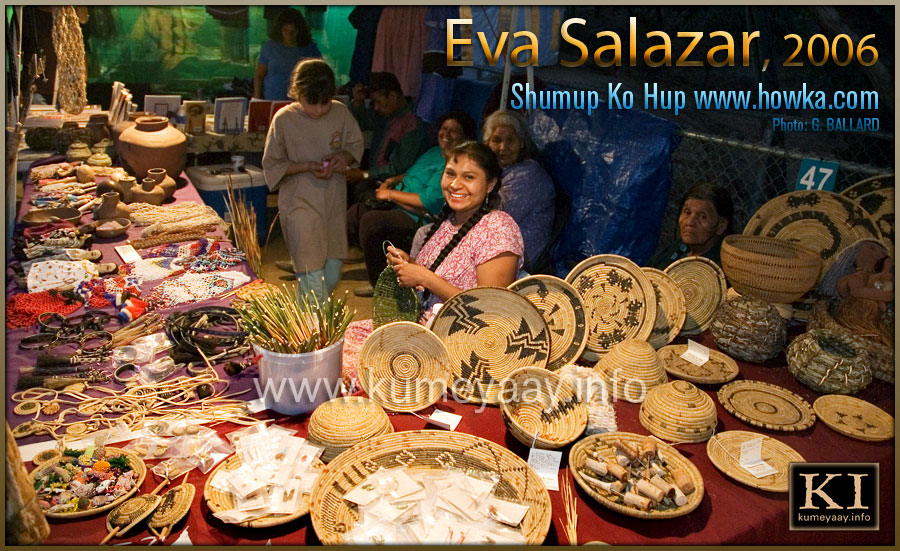
AUTHENTIC CALIFORNIA INDIAN ETHNOGRAPHIC Arts Crafts
REAL AUTHENTIC CALIFORNIA INDIAN traditional ethnographic arts and crafts, and famous Calif. Native American Indian artists, were featured at the pow-wow booth of SHUMUP KO HUP.
Pictured above is well-known Kumeyaay artist master basket weaver, Eva Salazar (in center of picture with braided hair). Eva Salazar owns the Shumup Ko Hup California Indian store in Old Town State Historic Park, and she is a successful working artist entrepreneur and community leader.
Also pictured is famous ethnographic artist Manuela Aguiar (seated behind Eva Salazar) and Manuela's sister, Teresa Aguiar (seated to the right of Eva). The sisters live in the Indigenous community rancho of Santa Catarina, Baja California, Mexico, a remote desert Native American ejido, and are featured in an exclusive KUMEYAAY.INFO California Indian documentary, including Paul D. Campbell's book: Survival Skills of Native California.
| Webmaster's note, December 2007: The Shumup Ko Hup store in Old Town fell under new management in 2007, and I think this 2006 picture makes a very important point about working ethnographic artisans. A born observer, I witnessed the success the store maintained under its original management and was impressed by the strength of its inner entrepreneurial circle -- how committed its buyer was traveling into Mexico over decades, motivating, teaching and supporting the Indian artists there to work hard, create and sell their finest traditional arts and crafts as gainful employment. Every item pictured on the table represents a story of one of these Native American Indian artists working to support his or her family by making the traditional items -- notice the quality and variety of the pieces. Only time will tell whether this small fragile community of working California Indian artists will dry up because they were unable to sell their finer work and earn a living -- or if the new management can step up and keep the Native artists working on anything close to this level, and maintain the healthy ethnographic market built by the original management. I will provide one tip: INVEST in the large Kumeyaay juncus baskets now because this photographic image may have documented the end of the Kumeyaay juncus basket renaissance in our lifetime. I say this because I am afraid the professional Kumeyaay basket weavers will have no means to market and sell their fine juncus coiled baskets. Also, that they will be unable to demand a fair price for their work (even calculated at minimum wage) and will be forced to quit weaving and find regular jobs off the reservations. Webmaster's note, December 2008: The new management dropped Shumup Ko Hup in 2008, so the California Indian artists must also all be going out of business in the New Economy...it is hard to tell if this type of authentic Indian art store will ever be brought back to health (or if these artifacts will only be found in museums in the future). Webmaster's note, February 2009: The owner did not renew the Shumup Ko Hup HOWKA.COM website and it was subsequently erased from the internet. KUMEYAAY.INFO is archiving parts of SHUMUP KO HUP for historical purposes. |
Authentic real Native American traditional ethnographic items for sale at the pow-wow booth included unique handmade traditional Kumeyaay Indian coiled juncus baskets (juncus earrings and jewelry, juncus hair barrettes, juncus pendant necklaces, juncus Kumeyaay hats, large and small decorative juncus trays, juncus bowls, juncus plates) which incorporate natural tan and red juncus, black dyed juncus, split juncus, palm, deargrass.
Many of the Kumeyaay coiled juncus "mission baskets" photographed were hand weaved by famous master basket weavers Native American Indian artists and include such unique tribal motifs such as as rattlesnakes, bats, butterfly, frogs, circles, triangles dancing Yuman women, and old pictographs tribal designs and petroglyphs patterns based on historic cave art designs and ancient Yuman Indian artifacts found in the greater Southern California area.
Also on exhibition and sale were large, medium and small Kumeyaay willow baskets granaries, Cocopah beaded pins, Indian horsehair accessories, traditional Native American Indian dolls, traditional agave fiber net bags, Kumeyaay and Pai-Pai coiled clay pottery art, California Indian ribbon dresses and traditional ribbon shirts, aboriginal clothing like willow bark skirts and agave fiber sandals, beaded collars and beaded capes, ceremonial white sage, Indian willow bows and arrows and yucca quivers, plus the entire Shumup Ko Hup library of California Indian books for sale.
Terms of Use • Privacy Statement • Site Map • Kumeyaay Indians Research